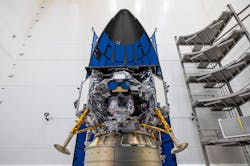Astrobotic uses Ansys simulation tech for its Peregrine lunar lander
PITTSBURGH - Astrobotic in Pittsburgh needed digital mission engineering and simulation technology as it prepares its Peregrine lunar lander. They found their solution from Ansys in Canonsburg, Pennsylvania.
Scheduled to launch in early January and land in late February, Peregrine will ferry 20 payloads from seven countries and will help NASA explore the lunar surface to prepare for human missions as part of the Artemis program.
Astrobotic, with support from SimuTech Group in Rochester, New York, used Ansys' topology optimization capabilities to help design a lander with mass savings of up to 20% while meeting structural durability criteria.
Engineers used Ansys Mechanical to help evaluate performance under extreme structural loads during the launch and transit, and the impact of shock, vibration, and fluid transients during powered descent.
Astrobotic engineers used Ansys Discovery to mature the stress design, reduce mass, and optimize Peregrine for assembly. In addition, Astrobotic analyzed the complex cislunar orbit and trajectory options across diverse thermal environments and spacecraft altitudes. This enabled the mission planning team to determine the most suitable launch and landing opportunities using Ansys Thermal Desktop. Finally, Astrobotic implemented Ansys HFSS to design the antenna radiation patterns to ensure maximum signal strength.
To reach the Moon, spacecraft traverse a hostile cislunar environment featuring extreme temperatures, unanticipated space weather phenomena, high levels of radiation, and a multitude of unknowns. The craft must be durable enough to withstand intense load-case scenarios during flight and landing, while remaining light enough to carry enough fuel for the journey. Because it is impossible to replicate these conditions with a physical prototype on Earth, Space 2.0 companies rely on Ansys' virtual design and mission planning to validate their technology and to maximize the chances of mission success.
"Ansys solutions helped us design and validate an innovative lander within a strict mission timeline that a manual approach would not have met," said Sharad Bhaskaran, mission director, Astrobotic. "Peregrine is poised to be one of the first U.S. spacecraft to land on the Moon since Apollo, so we put it through rigorous testing to ensure it has the durability to withstand extreme cislunar conditions. With expert engineering guidance from SimuTech and Space Exploration Engineering, we are confident the Peregrine is ready to pave the way for the future of lunar operations."
Space Exploration Engineering (SEE), a Laurel, Maryland-based aerospace firm specializing in planning space missions, mission analysis, and flight dynamics, leveraged Ansys' DME capabilities to support the mission. Using Ansys Systems Tool Kit (STK), SEE experts worked as part of the Astrobotic Flight Dynamics team to plan Peregrine's mission, trajectory, and maneuvers. The Astrobotic team used Ansys Orbit Determination Tool Kit (ODTK) to track the lander's orbital trajectory. It used STK to plan maneuvers and course corrections to achieve an accurate approach to the final landing site. SEE engineers augmented the existing mission capabilities by running the flight dynamics system, AstroFDS, which provides crucial automation of interfaces, workflows, and configuration control of Ansys ODTK and Ansys STK.
